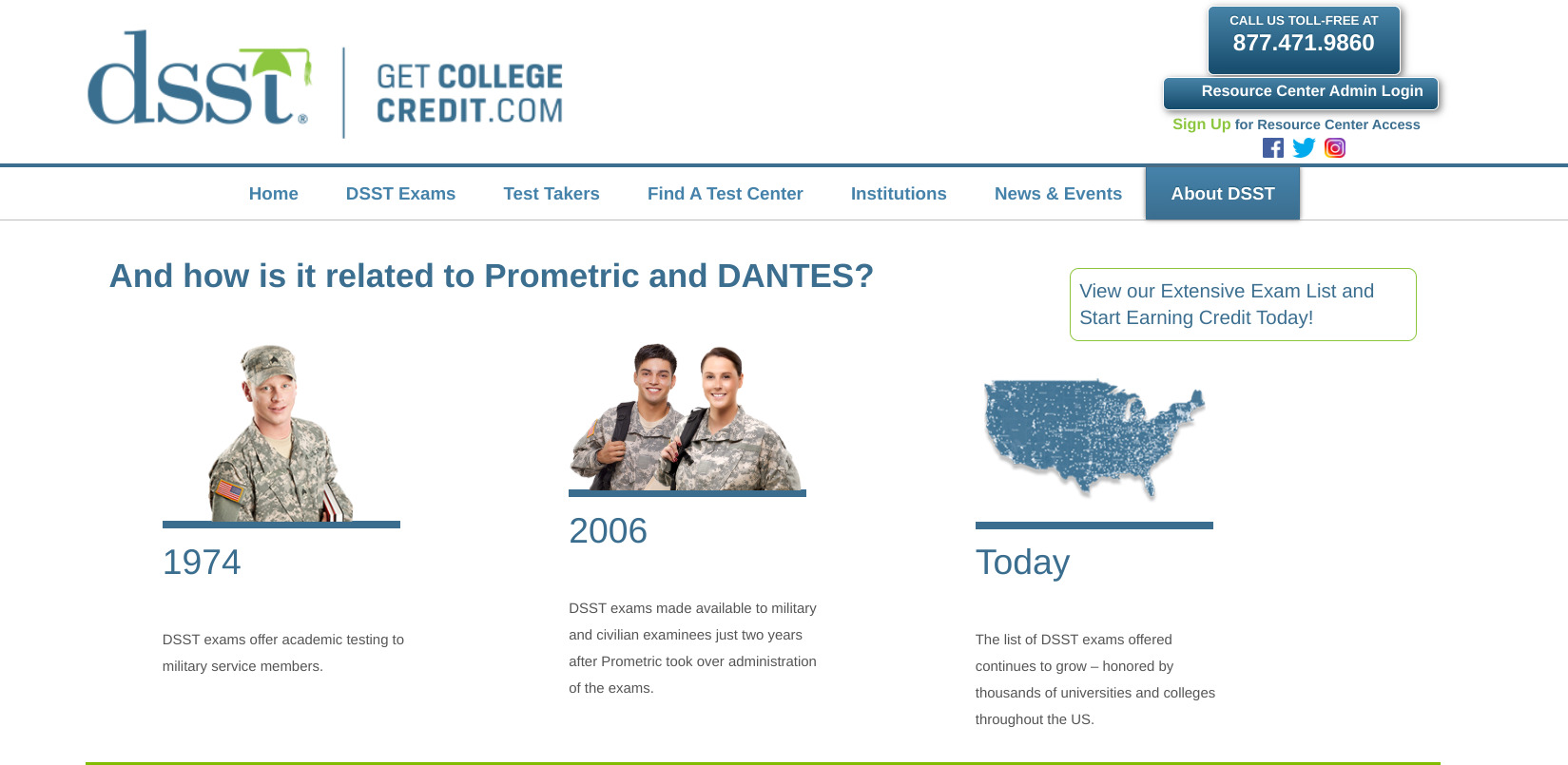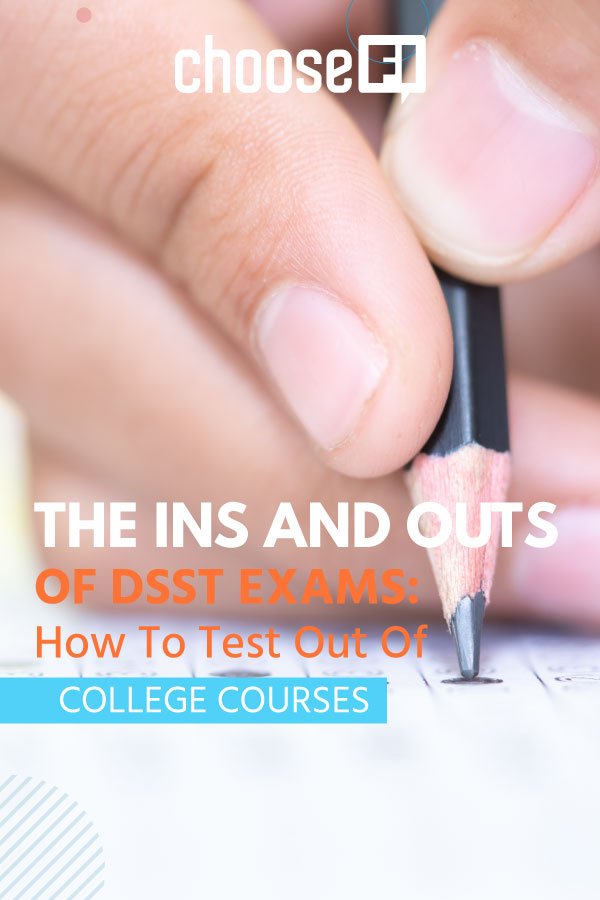According to a 2019 report on college trends by CollegeBoard, the average annual tuition cost in 2019-2020 for public in-state universities was $10,440. And the average tuition for private universities was a whopping $36,880 per year. So in order to get a four-year degree, your total cost of education will land somewhere between $41,000 to $147,000.
But what if you could earn some of your necessary college credits before you even graduate high school? With DSST exams, that’s totally possible. In fact, with these exams, your cost per course would drop to less than $90–and, in some cases, could even be $0.
Earning college credits through the DSST exam program has the potential to help you earn college credits for a lot less time and money. They can be a very smart college hack if you’re planning to major in a subject for which there is a DSST exam.To see if the DSST exams are a good fit for your college plans, let’s take a look at how the DSST program works and how it compares to the CLEP exam program, its more widely-known competitor.
Table Of Contents
- What Are DSST Exams
- The History of DSST Exams
- How DSST Exams Work
- DSST Exams Vs. CLEP Exams
- Bottom Line
What Are DSST Exams
DSST exams are similar to CLEP exams in that they allow students to earn college credits without taking the corresponding college courses. The DSST credit-by-credit program is nationally recognized and offers students over 30 exam titles.
The idea behind learning assessment tools is that students should have a chance to demonstrate knowledge that they’ve learned outside of the classroom. Students could learn the necessary information to pass a DSST exam through their own study and research or through on-the-job training or military field experience. The DSST program also offers practice tests and prep courses through their partnership with Peterson’s and DSST Prep.
Like CLEP exams, DSST exams are accredited by the American Council on Education’s College Credit Recommendation Service (ACE CREDIT). ACE CREDIT deems each of their existing exams to be worthy of college credit.
The History Of DSST Exams
The DSST exam program has actually been around for quite some time, having launched over 60 years ago in 1957. But for the lion’s share of the DSST program’s existence, its exams were only made available to military service members.
However, a major change took place in 2006 when Prometric purchased the distribution rights to DSST exams. Two years later, they began offering DSST exams to civilians in addition to the military community.
In the years since the program was opened up to the general public, DSST exams have grown in popularity. Today, there are thousands of both available testing facilities and academic institutions that accept DSST credits.
Listen: How To Get Paid To Go To College With Anthony Gary
How DSST Exams Work
If you’d like to take a DSST exam, begin by looking for a testing center near you and check out their testing schedule. Rather than register ahead of time online, you’ll register and pay for your exam in person on the day of the exam. Unless you qualify for free testing, you’ll need to pay $85 in addition to any administration fees that the testing site may charge.
When you register for an exam, you’ll be asked to provide the four-digit code of the school you’d like your test results sent to. Here is a list of academic institutions that accept DSST credits. The four-digit school code can be found on the left-hand corner next to the school’s name.
DSST exams are made up of 100 multiple-choice exams. You’ll have two hours to complete the exam. If you took your exam online, you’ll be able to view your results immediately. Scores for paper tests are sent through the mail. If you don’t pass a DSST exam, you’ll be eligible to re-take it after a 30-day wait period.
DSST Exams Vs. CLEP Exams
For those who want to earn college credits through learning assessments, DSST and CLEP are the two biggest national programs. As a property of CollegeBoard, CLEP gets a lot of publicity and mainstream attention. But by nearly every comparison metric, DSST exams are able to hold their own with the CLEP program. And DSST exams could even be a better fit than CLEP in certain situations. Here’s how the programs compare.
Available Courses
Currently, CLEP offers 34 exams while there are 37 DSST exams. There is a lot of overlap between the exams that each program offers. But there are also several differences. CLEP tends to stick to introductory subjects while DSST offer exams in more niche courses.
For example, here is CLEP’s exam list for “History and Social Sciences.”
- American Government
- History of the United States I
- History of the United States II
- Human Growth and Development
- Introduction to Educational Psychology
- Introductory Psychology
- Introductory Sociology
- Principles of Macroeconomics
- Principles of Microeconomics
- Social Sciences and History
- Western Civilization I: Ancient Near East to 1648
- Western Civilization II: 1648 to the Present
And here are the exams that DSST offers in the Social Sciences category:
- A History of the Vietnam War
- Art of the Western World
- The Civil War and Reconstruction
- Criminal Justice
- Foundations of Education
- Fundamentals of Counseling
- General Anthropology
- Introduction to Geography
- Introduction to Law Enforcement
- Lifespan Developmental Psychology
- History of the Soviet Union
- Substance Abuse
In most cases, introductory courses are a safer bet. Why? Because you’re likely to need them no matter which major you choose.
However, for certain students, DSST’s specialty courses could be helpful. For example, imagine that you knew you wanted to pursue a career as an attorney or prosecutor. In that case, DSST could be the better option since they offer exams in Criminal Justice and Introduction to Law Enforcement.
Exam Categories
There are also slight differences in the overall categories that these two programs offer. Here are CLEP’s five exam categories:
- Composition and Literature
- World Languages
- History and Social Sciences
- Science and Mathematics
- Business
And here are the six exam categories that DSST offers:
- Business
- Humanities
- Math
- Physical Science
- Social Sciences
- Technology
You’ll notice that only the CLEP program offers a category for World Languages, and only DSST offers a Technology category.
Testing Facilities And Participating Academic Institutions
CLEP is the winner here in both categories. They currently have over 2,000 testing centers, while DSST has just over 1,200 testing facilities. You can use CLEP’s find-a-test-center tool to look for nearby centers. And here is DSST’s testing facility search tool.
CLEP says that over 2,900 academic institutions accept CLEP credits, while DSST exams are accepted by over 1,900 schools. While both programs have a lot of participating schools, that’s an extra 1,000 or so institutions that accept CLEP credits that don’t accept DSST credits.
Use CLEP’s handy tool to see which CLEP exams are accepted by each institution and what CLEP score you need to receive credit.
Exam Preparation
Both programs offer tools and resources to help students prepare for their exams. DSST has partnered with both Peterson’s and DSSTPrep to offer exam preparation materials. You can find discounts for these materials on DSST’s test prep page.
Prometric offers free practice tests for the following exams:
- Business Ethics and Society
- Computing and Information Technology
- Criminal Justice
- Environmental Science
- Ethics in America
- Fundamentals of College Algebra
- Fundamentals of Cybersecurity
- Health and Human Development
- Introduction to Geography
- Human Resource Management
- Introduction to Business
- Introduction to World Religions
- Lifespan Developmental Psychology
- Management Information Systems
- Organizational Behavior
- Principles of Public Speaking
- Personal Finance
- Principles of Statistics
- Principles of Supervision
- Substance Abuse
- Technical Writing
- The Civil War and Reconstruction
Each year, CLEP releases a new official exam study guide. It has practice questions for each of their 34 exams. If you plan to take multiple exams, this overall guide will probably be your most affordable choice. However, you can also choose CLEP’s individual exam guides, which could be a better choice if you only plan to take one or two exams.
Would you like to take an actual course to help you prepare for a CLEP exam? You can take a FREE CLEP exam prep course through Modern States’ Freshman Year for Free program.
Exam Fees
DSST and CLEP are nearly identical in the cost of their exams. The CLEP exam fee is $89, while DSST exams cost $85. Both programs offer free testing for eligible military members at DANTES fully funded centers.
DSST says there are over 700 DANTES fully funded centers that can administer their exams, and you can learn more about their DANTES fully-funded facilities and eligibility requirements here. CLEP doesn’t give a specific number. Also of note is that DANTES will only cover the fee for your first sitting for any particular exam. You’ll need to pay the fee yourself for any exam retakes.
However, there are other ways to get your exam fees waived. Students can earn up to a full year’s worth of college credits for FREE via CLEP’s partnership with Modern States and their Freshman Year for Free program.
Students can take up to ten of the most popular DSST exams free of charge (including the sitting/administration fees) by taking the exam at a location operated by Prometric.
Related: 5 Ways To Save Money On College Tuition
Bottom Line
According to DSST, the average college course costs $750 for a three-credit course. So with either the DSST or CLEP exam programs, you could save over $650 per course vs. what you would pay to earn those same credits in the classroom!
If you’re looking for the program with the largest number of accepting academic institutions and available testing facilities, you’ll want to go with CLEP. But DSST exams could be a better choice if you’re looking to earn credits for courses that CLEP doesn’t currently offer.
Related Articles





